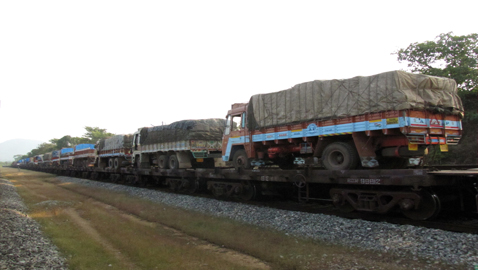

Railway Minister
Railway Budget 2015-16, presented by India’s Railway Minister Suresh Prabhu on February 26, has pegged operating ratio at 88.5 per cent, against 91.8 per cent in 2014-15 and 93.6 per cent for 2013-14. Gross Traffic Receipt is estimated to be Rs.1,83,578 crore which is a growth of 15.3 per cent. Passenger earning is budgeted to rise by 16.7 per cent to Rs.50,175 crore; freight earning is projected at Rs.121,423 crore, which includes increase due to rationalisation of rates, commodity classification and distance slabs.
The budget has not proposed any increase in passenger fares. Other coaching and sundries are expected to be Rs.4,612 crore and Rs.7,318 crore, respectively. In the meantime, the growth in passenger earning during 2014-15 has been scaled down to 17.7 per cent (RE) from 22.2 per cent (BE), keeping in view the persistent negative growth trend, particularly in non-suburban non-PRS segment of travel. There is a net reduction in Gross Traffic Receipts of Rs.917crore in RE compared to the BE of Rs.1,60,165 crore.
No new trains have been announced in the budget but speed of trains under nine railway corridors will be increased.
The size of the Railway Plan would go up by a record high 52 per cent from Rs.65,798 crore in 2014-15 to Rs.1,00,011 crore in 2015-16. The central support to the Plan would be Rs.40,000 crore. Market borrowing under EBR is projected at Rs.17,655 crore, internal resources at Rs.17,793 crore and PPP at Rs.5,781 crore.
Five-Year Plans
The railway minister has also proposed a 2015-19 Railway Transformation Plan involving a capital outlay of Rs.8.56 lakh crore. Over these years, Indian Railways will increase daily passenger carrying capacity from 21 million to 30 million, annual freight capacity from 1 billion to 1.5 billion tonnes, and track length by 20 per cent to 1,38,000 km.
Some specific capex proposals:
* 77 new railway projects sanctioned at an outlay of Rs.96,182 crore.
* 970 ROBs/RUBs to eliminate 3,438 level crossings (Rs.6,581 crore).
* Fast-tracking sanctioned works on 7,000 km of double, third and fourth lines, and commissioning of 1,200 km during the year (Rs.8,686 crore).
* 200 more stations to come under Adarsh Station scheme; Wi-Fi to be provided at ‘B’ category stations.
* 9,400 km of doubling, tripling and quadrupling works proposed.
* Developing 10 satellite railway terminals in major cities.
* Installation of train protection warning system and train collision avoidance system on select routes.
* Lifts and escalators at major stations (Rs.120 crore).
* Construction of longer loops, smaller block sections, bypass lines and augmenting terminals (Rs.2,374 crore).
* Coastal Connectivity Programme in partnership with ports for Nargol, Chharra, Dighi, Rewas and Tuna.
| PROPOSED INVESTMENT PLAN (2015-2019) (Rs. crore) | |
| Network decongestion (including DFC, electrification, doubling including electrification and traffic facilities) |
1,99,320 |
| Network expansion (including electrification) | 1,93,000 |
| National projects (northeastern and Kashmir connectivity projects) |
39,000 |
| Safety (track renewal, bridge works,ROB, RUB and signalling and telecom) | 1,27,000 |
| Information technology and research | 5,000 |
| Rolling stock (locomotives, coaches, wagons – production and maintenance) |
1,02,000 |
| Passenger amenities | 12,500 |
| High-speed rail and elevated corridor | 65,000 |
| Station redevelopment and logistic parks | 1,00,000 |
| Others | 13,200 |
| Total | 8,56,020 |
‘Much needs to be done for mobility reduced passengers’
 — Sminu Jindal, MD, Jindal Saw & Founder Svayam:
— Sminu Jindal, MD, Jindal Saw & Founder Svayam:
Steps like introduction of Braille enabled coaches and facility of online booking of wheelchairs is a welcome step. This means that the government is thinking about the mobility reduced populace.
However, much needs to done at the basic level. Tactile guiding blocks and warning blocks are missing which need to be placed to guide the visually impaired find their way around railway station. So even though there will be Braille markings on the coaches and seats (we hope the seat numbers are included), this alone will not suffice.
The website is still inaccessible to the visually impaired, so as a first step even the website of IRCTC needs to be made accessible. Most railway stations still do not have accessible access to platforms, between platforms and to coaches
Public conveniences like accessible toilets are missing so while it’s good that the railway minister is focusing on bio-toilets and cleanliness, perhaps he would also focus on providing accessible toilets in the train and on platforms.
There’s a lack of visual signage at the platforms which is a deterrent for the hearing impaired.
‘Bombardier is keen on PPP projects’
 — Harsh Dhingra, Chief Country Representative, India, Bombardier Transportation
— Harsh Dhingra, Chief Country Representative, India, Bombardier Transportation
We are pleased with the overall direction of the railway budget, which stresses on safety, increasing train speeds, outlaying investment opportunities through banks and pension funds, upgrading existing rail infrastructure with increase track capacity, and improving passenger comfort and technology innovations.
This budget provides a long-term vision of rail transportation in India with a clear focus on stabilising railways in India and making itself sustainable.
This is the first rail budget which has utilised the professional management background of the railway minister outlining nine thrust areas and five drivers for executing strategies with four defined goals to transform Indian Railways in the next five years.
The budget reinforces commitment to private sector with stress on public-private partnerships, which is a win-win situation for the private sector and Indian Railways.
Bombardier is one of the major global suppliers of electric locomotives and high-speed trains across the world and we are delighted with the prospects of such projects gaining momentum in this budget.
Setting up of an infrastructure fund for raising long-term debt from domestic and overseas sources including pension funds, bilateral and multilateral financial institutions is a step in the right direction.
Mega rail projects require high level of technology and investments. These projects might prove to be significant to India with technology injection and enabler to economic growth.
Emphasis on “Make in India” is ideal for Bombardier Transportation as our large industrial base in India is already manufacturing complete rail equipment for Indian and overseas markets. High horse power and green technology locomotives along with high-speed train sets gives Bombardier an opportunity for enhancing support to ‘Make in India’ initiative.
Proposed investment outlay of Rs.856,000 crore will be spent in the next five years and Bombardier will keenly follow projects under rolling stock and signalling systems which represent reasonable portion of the total proposed investment outlay
‘Emphasis is on strategy and action plan’
 — Tilak Raj Seth, Executive VP – Mobility, Siemens Ltd
— Tilak Raj Seth, Executive VP – Mobility, Siemens Ltd
Overall, Railway Budget 2015-16 emphasises on an execution strategy and action plan for the transformation of the Railways. I would rate this Railway Budget as very positive, as it would be beneficial for the industry, Siemens businesses and people at large.
Demand for railway transportation services is directly linked to the growth in the core infrastructure industries and through this budget, the ministry has made an honest attempt to present a structured blueprint for transformation of the railways.
Apart from various measures to improve passenger amenities, increasing safety (Train Protection Warning System), capacity augmentation in high-density network areas and enhanced customer experience are welcomed.
The implementation of the key projects, including dedicated freight corridors and high horse power locomotives, will provide additional opportunities for the industry. Public-private partnership projects will benefit from the operational efficiencies of private sector and domain expertise of the Railways.
With our broad competencies, we are confident of partnering the Indian Railways in their ambitious plans to modernise signalling and safety system, dedicated freight corridors etc.










